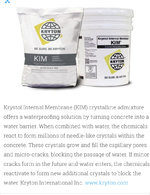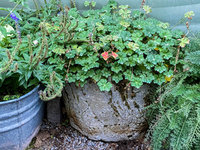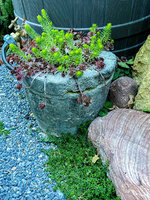@moke - I missed the original post earlier. Nice work. The product you chose, Vinyl Concrete Patch, is exactly the type of product I would suggest for pots and slabs, as these are ''thin'' applications for concrete. Good choice. It is a Portland cement mix, with a vinyl component that adds flexibility to the set product. The addition of fibers really reduces fine cracking, and using an expanded metal mesh will add structural strength. Well done.
I believe Eric K uses
Ciment Fondue, a product more readily available in EU, not really used much in North America, except for certain specific applications. The Vinyl Concrete Patch product is based on Portland Cement chemistry, which I understand to some degree.
Ciment Fondue is not Portland Cement, it is a cement with a much higher aluminum content, and much lower silica content than what is found in Portland Cement. The chemistry is somewhat different, and it reacts differently to additives than portland cement. It is also more expensive than portland cement. It does make a good finished product, as Eric K has proved.
Ciment Fondue is used in foundry applications, because it is stable to much higher temperatures than Portland Cement.
@BE.REAL - mixing peat moss or any water absorbent material, like paper into a concrete mix
will guarantee freeze thaw damage. With the ''hypertufa'' the spalling off of the outer surface over time, the cracking and crumbling is all part of the ''charm''. Actually a design benefit. But if you want long lasting pot or slab, do not mix any organic material into the mix. In frost free Florida, hypertufa can last 100 years. In Illinois, it might last 5 winters. But it will ''look cool'' as it degrades.
Separately I also question your addition of unslaked lime or lye to the mix. I am retired from the concrete admixtures manufacturing, and I never heard of unslaked lime, calcium hydroxide or sodium hydroxide, adding any freeze thaw resistance to a concrete mix. The concrete mix already contains a significant amount of calcium oxide, which becomes the unslaked lime or lye when added to water, adding more will do nothing more than weaken the final strengths of the concrete more towards the properties of mortar. Mortars are based on the dominant binding agent being calcium oxide reacting with water to make calcium hydroxide which reacts with carbon dioxide to make calcium carbonates (limestone). The superior strength of Portland cement depends on calcium aluminosilicates hydrating to form a much stronger matrix than calcium carbonates could form. There is calcium oxide in portland cement, but the percentage is low compared to the anhydrous aluminosilicates. Adding extra calcium hydroxide merely weakens the mix more toward the properties of mortar. Not good for frost-freeze resistance.
It is possible that
@BE.REAL - you might be thinking of the addition of calcium chloride to concrete mixes. Here the effect of the calcium chloride is that it accelerates the initial set up of the concrete, allowing normal set times when the concrete is poured in cold weather. So you would see calcium chloride added in cold weather, but it actually acts on speeding up the initial strengths, and actually slightly lowers the end final strengths. Set time is temperature dependent, and for most jobs, if it is below 50 F outside it is normal to add an accelerator to the concrete mix. This is probably what you were thinking of. If you use metal, especially aluminum or iron mesh or rebar in your concrete - added chlorides, like calcium chloride will have a chemical reaction that will eventually corrode the metal and cause the concrete to fail. That is why calcium chloride is not allowed to be used in bridges, tall buildings or nuclear power plants. It is okay for house foundations, the least demanding task for concrete to perform. I hope you don't feel I'm ''busting your chops'' that is not my intent. I just don't want others to accidentally screw up their own projects by following what was probably an accidental mis-statement you made. And since I worked in the business, I thought I'd set the record straight.
There are techniques and additives that would help with freeze thaw resistance.
# 1. - One is to use as little water as possible to your mix. You want to add just barely enough to make a smooth, but still stiff paste. The amount of water needed for the various hydration reactions is so little that if you only added what the chemistry required, the mix would still seem ''dry to almost dusty''. The extra water makes it easier to work with, but the water as it evaporates leaves micro-channels, that allow water to re-enter the concrete, and when the concrete freezes, the water expands and cracking begins.
#2. - use a Portland cement mix with an additional polymer in the matrix, such as vinyl, there are also acrylic - cement mixes. These are high tech mixes, designed for patching, and have complex chemistries that should not be ''messed around with'' in the mixing process. Just follow the directions.
#3. - adding a plastic fiber, who's shape was cut to maximize strengthening the concrete (like little bow ties). This is what Moke did. Good move. Sometimes after the concrete is set you can feel the fibers sticking out from the cement paste. Just hit the finished piece with sand paper to sand the surface smooth. They will smooth right out.
For small batches of concrete, the above is all I would do. Until you get a batch size closer to one ton or more of concrete any chemicals you could add would have to be added in very small amounts. Not easy to get right without laboratory scales or volumetric equipment. Some are also not exactly safe to handle in a home setting. For large scale construction, to make extremely freeze thaw resistant concrete the redi-mix plants will add various soap like compounds to entrain air voids for the ice to back up into, naphthalene condensates and or lignin liquors to reduce total amount of water added, silica fume to create a more dense concrete, and a host of other chemicals.







